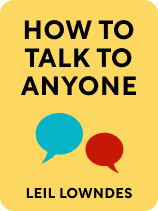

This article is an excerpt from the Shortform book guide to "How to Talk to Anyone" by Leil Lowndes. Shortform has the world's best summaries and analyses of books you should be reading.
Like this article? Sign up for a free trial here .
What is Leil Lowndes’s How to Talk to Anyone about? What is the key message to take away from the book?
In How to Talk to Anyone, Leil Lowndes reveals the secret to getting people to want to talk to you. He presents practical techniques to help you overcome social discomfort, make a great first impression, and confidently develop new social and professional connections.
Below is a brief overview of the key themes from How to Talk to Anyone by Leil Lowndes.
People Need to Know You Like Them
In her book How to Talk to Anyone, Leil Lowndes asserts that the key to being able to approach and talk to anyone is to, first and foremost, make people want to talk to you. According to Lowndes, people will only want to talk to you if they know you like them. This is because, no matter the context—social or professional—everyone wants to feel adored, appreciated, and good about themselves.
Lowndes argues that the need to be liked governs all social interactions. When people are unsure about whether or not you like them, they feel self-conscious. This makes them feel uncomfortable and they struggle to engage with you. On the other hand, when they’re sure that you like them, they feel at ease around you and enjoy your company—they like you because you make it easy for them to feel good about themselves.
While showing people you like them sounds quite simple, many people find it difficult to put into practice because they let discomfort get in their way. When you meet someone, you also want them to like you. This can create discomfort and a fear of rejection, which, according to Lowndes, has a self-fulfilling effect: The more uncomfortable you feel, the more likely you are to unconsciously emit nonverbal and verbal “I don’t like you” signals—thus repelling the very people you wish to engage with.
Lowndes suggests a simple solution to overcome your discomfort and send welcoming signals to the people that you want to talk to: Switch your focus from how you want to feel to how you want to make them feel. This involves becoming conscious of the nonverbal and verbal signals you’re emitting—we’ll explore these signals throughout the rest of the guide.
Part 1: Nonverbal Signals—Make a Positive First Impression
To become good at talking to anyone, you must pay attention to your body language and the nonverbal signals you’re emitting. Since Lowndes’s focus is on helping you talk to anyone, you might wonder why nonverbal signals are so important. According to Lowndes, these silent signals contribute to more than 80% of people’s first impressions of you and influence the way they react to you.
Your Body Language Communicates Everything About You
Lowndes argues that you form an instinctive impression of everyone you come across within the first few seconds of seeing them. Before someone gets a chance to utter her first words, you’ve already made assumptions about her personality, her feelings, her confidence levels, and her social or professional status. Most importantly, you’ve already decided whether she’s the type of person that you want to spend time with. Likewise, people make assumptions about whether they want to talk to you as soon as they set their eyes on you.
What forms the basis of these assumptions? According to Lowndes, it’s your body language—this includes your posture, how comfortable you appear, the way you smile, and the way you make eye contact. Whether you’re conscious of it or not, your body language constantly emits signals about the way you feel.
How to Appear Approachable and Likable
Lowndes argues that in Western society, people instinctively know how to distinguish between nonverbal “I like you” signals and “Get away from me” signals. As previously discussed, people gravitate toward those who appear to like them. Therefore, you can appear more approachable by becoming conscious of the signals your body language is sending and making sure they’re saying, “I like you.”
Lowndes decodes this silent language and explains how to create a positive impression throughout the following five techniques.
Technique #1: Stand Tall
According to Lowndes, people interpret poor posture as an unwelcoming signal. Trying to minimize your physical presence by slumping implies that you’re insecure or ashamed and don’t want to be approached.
People interpret good posture as a welcoming signal because it implies that you’re proud and confident and have nothing to hide. This tricks them into assuming that you’re an accomplished person who deserves their attention.
Technique #2: Relax and Remove Physical Barriers
Lowndes claims that people interpret fidgeting and guarded movements as insincerity because they make you look suspicious and defensive:
- Fidgety movements, such as shuffling your feet or touching your face, come across as signs of discomfort, tension, or distraction.
- Guarded movements, such as folding your arms or clutching something in front of your body, also convey discomfort. Additionally, they give the impression that you’re placing barriers between yourself and other people.
On the other hand, Lowndes argues, people interpret a relaxed and open stance as a sign of an honest and welcoming personality because it signals that you’re calm, unafraid of appearing vulnerable (because you have nothing to hide), and approachable. To come across as calm, self-assured, and trustworthy, practice keeping your arms loosely by your sides with your palms and wrists faced upwards. If you’re approached by people you want to talk to, turn your body totally towards them to show them they’ve got your full attention—this implies that you’re happy to be in their company and puts them at ease.
Technique #3: Delay Your Smiles and Maintain Eye Contact
According to Lowndes, people don’t respond warmly to quick, instinctive smiles because they interpret them as impersonal—they assume that you’re flashing that smile at anyone you come across. This impels them to respond in kind, by acting detached or distant.
Another behavior that puts people off, Lowndes argues, is a lack of eye contact. Others interpret it as a sign that you’re either distracted or uncomfortable, and this makes it difficult for them to form an emotional connection with you.
To get a warm response, Lowndes suggests that you avoid your instinct to flash a quick smile at anyone you meet. Instead, look the recipient in the eyes, pause briefly, and then let out a big warm smile while maintaining eye contact. The delay will convince recipients that you’re smiling just for them and they’ll instantly feel like you’re happy to meet them. As you continue your conversation, attempt to maintain a comfortable amount of eye contact to convince them that you’re interested in what they have to say.
Technique #4: Pretend You’re Already Close Friends
Lowndes suggests a way to automatically trick your body into sending positive signals: Pretend that you’re already close friends with the people you want to talk to. She argues that you only feel—and broadcast—discomfort when you’re feeling unsure about how others will respond to you. However, when you imagine that you’re already close friends, you remove this uncertainty and automatically feel more relaxed and comfortable around others.
According to Lowndes, pretending to like others feels so good that it eventually turns into genuine affection. While you’re initially only pretending to like them, you’re sending signals that put them at ease—encouraging them to like you and respond warmly to you. This makes you want to like them, resulting in a genuinely comfortable and enjoyable interaction.
Technique #5: Hold Their Gaze to Encourage Attraction
If you’re attracted to someone, instead of playing coy, hold their gaze for as long as possible. Lowndes argues that strong eye contact is more likely to invite a positive response because it makes the recipient feel like she’s captivated you. Your obvious interest in her triggers a nervous, biological response that’s similar to what happens when people fall in love: It increases her heartbeat and pumps adrenaline into her bloodstream. Because she’s not conscious of why she’s experiencing this nervous physical reaction, she interprets it as a sign of mutual attraction and intimacy.
To encourage attraction, maintain eye contact with your recipient even when others in your group are speaking. If you must look away, do so slowly and reluctantly—as if you’re so enthralled that you can’t look away. To make it less intense, let your eyes bounce between your recipient and back.
Lowndes warns that intense eye contact should be used with caution. If your intended recipient has already decided that she’s not attracted to you, she’ll interpret your attention as arrogance and won’t respond well.
Tune Into Their Body Language
So far, we’ve discussed how to align your body language in a way that sends positive, welcoming signals to the people that you want to talk to. However, this doesn’t mean that you should just sit back and wait for them to approach you. Let’s take things one step further and explore how to use this knowledge to proactively approach others.
Since most people are unaware of the nonverbal cues that they emit, you now have a distinct advantage in social situations because you know how to:
Differentiate between those who want to be approached and those who don’t: A relaxed and open stance implies that you’re welcome to approach them. If they’re slumped, guarded, or fidgety, you probably won’t get the warm response that you want.
Interpret how people feel about you during interactions: If they turn their body fully towards you and maintain eye contact, they’re interested in you and want to engage with you. If they physically turn away, fidget, or avoid eye contact, they’re either uncomfortable or distracted—in either case, they’re not giving you their full attention.
If you find that the people you want to talk to you appear unapproachable or inattentive, Lowndes suggests three ways to influence them to respond to you more positively:
1) Approach them anyway: As long as you use the techniques discussed above and don’t say anything rude or unpleasant, they’ll pick up on your positive signals and instinctively feel more comfortable around you.
2) Mirror the way they move: Maintain your open posture and eye contact but also imitate their gestures. This gives the impression that you’re similar in nature and instantly puts them at ease. For example, if they use their hands to make a point, use yours in the same way.
3) Take steps to change their body language: Play with changing your tone or the topic of conversation while keeping an eye on how they’re responding to you. When you find something that puts them at ease or triggers their interest, they’ll automatically warm to you and their body language will reflect this.
Part 2: Verbal Signals—Create Instant Rapport
Now that you understand how to send positive and welcoming nonverbal signals, let’s discuss how using the right verbal signals enhances the way people perceive and respond to you. Lowndes maintains that you’ll enjoy pleasant interactions if you put your conversation partners at ease and focus on making them feel as if you like them. She suggests four techniques to help you achieve this.
Technique #1: Use and Take Notice of Visual Gimmicks
Lowndes suggests an easy way to start conversations: Draw attention to yourself by wearing or carrying something unusual, such as a unique brooch or a colorful shirt. This gives people an excuse to approach you and gives you something to talk about. Likewise, pay attention to what those around you are wearing or carrying so that you have an excuse to approach them. Using a complimentary phrase such as, “Wow, I love your shoes! Where are they from?” not only helps you to start a conversation, but it also shows others that you’re interested in them and what they have to say.
Technique #2: Ask for Introductions
According to Lowndes, another effective way to approach new people is to ask mutual acquaintances to make introductions for you. Before they introduce you, ensure that they’ll pad out these introductions with a few details, such as the new person’s hobbies or interests, so that you have the opportunity to show your interest and start a discussion.
Alternatively, if your acquaintances are too busy to introduce you, ask them for information so that you can find a shared interest to use as an icebreaker. With this information, you can easily approach someone new using a variation of the following line: “Hey, I was just talking to … and she told me that you …”
Technique #3: Prepare Stimulating Responses to Common Questions
When people first meet each other, they usually ask two questions: “Where are you from?” and “What do you do?” Normally, they each respond with fact-based answers—for example, “I’m from New York and I’m an engineer.” But, Lowndes argues, this sort of answer shuts down a conversation—if your conversation partner’s never been to New York or knows nothing about engineering, they won’t know how to continue the conversation.
Instead, Lowndes suggests extending your responses to these two questions in a way that stimulates a response—by using interesting facts, jokes, or general observations. This requires coming up with different variations depending on who you’re talking to and the social context you’re in. If you’re seeking to make friends, keep your responses fun and general. For example, “I’m from X—where they make the best goat’s cheese in the world.” If you’re talking to them for networking purposes, consider what interest this person could have in you or your work and include that in your response. For example, “I’m an engineer and have been working on X for the past two years.”
Technique #4: Research Interesting Things to Say in Advance
Once you’ve discussed where you’re from and what you do, you’ll need other topics to lure people into conversations and keep them engaged. Lowndes suggests four ways to prepare yourself for interesting conversations:
1) Find out who will be there: Before you accept an invitation, find out what type of people will be there—will it include people from a single profession or interest group? Knowing what types of conversations you’ll be expected to engage in will help you prepare for them.
2) Listen to the news: This will keep you up to date on current affairs and will provide common topics to discuss.
3) Continually try new activities: Restricting yourself to specific activities limits your ability to engage with people who have other interests. The more you try out or read about different activities, the easier you’ll find it to communicate with a wider range of people.
4) Broaden your vocabulary: In addition to researching things to say, think about how you say them. Make yourself sound more interesting by replacing your most common words with alternatives. Look through a thesaurus to find words that suit your personality and reflect how you want to come across to others.
Part 3: Verbal Signals—Encourage Meaningful Conversations
The four techniques we’ve just covered will help you feel more comfortable about approaching others to discuss a variety of topics. But what if you’re hoping to engage in more meaningful conversations? According to Lowndes, if you want to move beyond superficial conversations, you’re going to have to build an emotional connection with your conversation partner.
What is an emotional connection? To put it simply, it’s when people trust each other enough to reveal more about themselves—who they are and how they really feel about things. Lowndes explains that it’s at this stage that conversations move from being superficial to being meaningful.
She suggests four techniques to help build trust so that you can develop an emotional connection.
Technique #1: Make Your Interest in Them Clear
Ask them questions to learn more about how they spend their time and give them space to talk about themselves. Then mention how much you enjoy listening to them and find a way to relate your own interests to theirs. According to Lowndes, this approach will endear them to you because it signals that you’re interested in who they are and what they care about.
Remember details for future conversations: Write down interesting facts about the people you talk to so that you can refer to them the next time you meet them. Alluding to things that they’ve previously shared about themselves instantly makes them want to reveal even more—because it demonstrates that you’ve been paying attention to them and care enough to remember little details.
Technique #2: Present a Positive Image of Yourself
Be conscious of revealing your flaws. Many people assume that they can make themselves appear more endearing by throwing in self-effacing remarks. However, Lowndes argues, this tactic produces different effects depending on your professional or social status.
- If you’re higher in status (for example, if you’re talking to your employee), this tactic can humanize you and put the other person at ease.
- On the other hand, if you’re lower in status (for example, if you’re talking to the CEO of a company you want to work for), this tactic reduces your credibility because your conversation partner doesn’t know you well enough to put your flaws in context.
Therefore, Lowndes argues, you should think carefully about your status and how positively or negatively others will perceive you before resorting to this common tactic.
Technique #3: Maintain a Positive Image of Them
Focus your attention only on the good things about them. Don’t put them down or make jokes at their expense. Likewise, don’t draw attention to their faults—for example, if they fumble in some way or say something inappropriate. Instead, do your best to make them feel comfortable and accepted for who they are. According to Lowndes, the more you focus on their good qualities, the more they’ll appreciate you for seeing the best in them.
One way to put this into practice is to give genuine compliments. Think about what you’re learning about them and what they seem to care about and use complimentary statements to uplift them. This will make them feel appreciated and will encourage them to continue talking. For example, if they’ve been discussing parenthood, say something like, “Well, it sounds like your children are lucky to have you.”
Technique #4: Foster Empathy Through Mirroring Techniques
According to Lowndes, people feel more comfortable revealing the truth about themselves to those who seem to be just like them—those who share similar traits, interests, and values.
She suggests that you can encourage people to believe that you’re just like them by adopting the following four tactics.
Tactic #1: Match Their Mood
Show that you empathize with their emotions by tuning into their mood and matching their tone and pace. This will make them feel like you’re on the same wavelength as them. For example, if they talk quickly because they’re excited about something, try to maintain that high when you speak.
Tactic #2: Repeat Their Words Back to Them
Listen to the specific words they use and echo them back when it’s your turn to speak. Finding ways to incorporate their vocabulary into what you say will make them believe you share their values and think like them.
Tactic #3: Make Supportive Statements
Show that you understand what they’re feeling by using short empathetic statements that match the senses they use to express them. For example, if they talk about how they saw something, you could say, “I see what you mean.” If they talk about how they felt about something, you could say, “I understand how you feel.” These short sentences will make them believe that you interpret the world in the same way that they do and will encourage them to continue. Additionally, this tactic helps to keep the conversation flowing if you find yourself at a loss for words.
Tactic #4: Use “We,” “Us,” and “Our” to Imply Friendship
Create a feeling of connection and intimacy by using language that presupposes that you’re already friends. When people are in a close relationship, they automatically refer to themselves with words that unite them, such as “we” and “us.” Using these words tricks others into believing that you’re already friends. For example, instead of saying, “I’m going to find some food,” say, “Shall we find some food?”

———End of Preview———
Like what you just read? Read the rest of the world's best book summary and analysis of Leil Lowndes's "How to Talk to Anyone" at Shortform .
Here's what you'll find in our full How to Talk to Anyone summary :
- Practical techniques to help you overcome social discomfort
- How to confidently develop new connections
- How to appear more likable without saying a word






